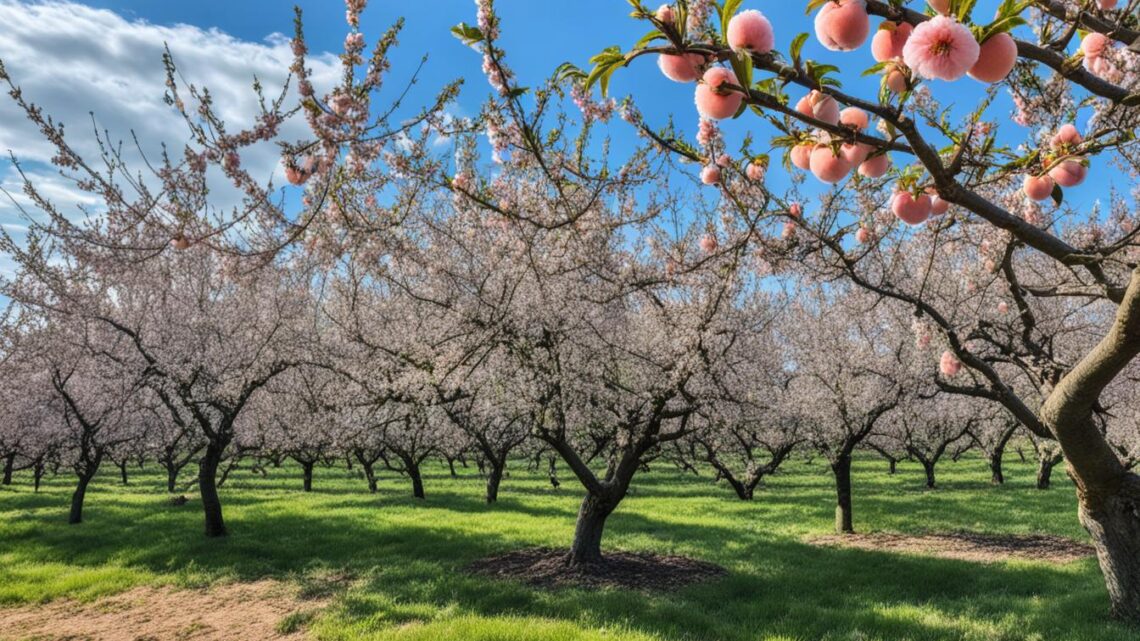
Do you dream of picking juicy, sweet peaches from your own yard? Growing peach trees can be fun and rewarding, even for beginners. But what does it take to grow a peach tree that gives lots of fruit every year? Learn how to grow peach trees well in this guide.
Peach trees are great for home gardens, giving you sweet peaches every summer. This guide will show you how to pick the best spot for your tree and keep it healthy. It’s perfect for both experts and new gardeners. You’ll get tips to make your peach trees grow well and give you lots of delicious fruit.
The Sweet Aroma of Homegrown Peaches
The sweet smell of ripe homegrown peaches is unmatched. They burst with freshness and have a unique flavor of homegrown peaches. Peach tree blooms are beautiful in spring. The trees also give shade in the summer.
Kids love picking their own fuzzy peaches from the tree.
Flavor and Freshness Unmatched by Store-Bought Varieties
Store-bought peaches may be cheap, but they can’t beat the taste of homegrown ones. High-end markets sell tree-ripened peaches for up to $5 a pound. The Georgia Peach Truck offers peaches that taste much better than store ones.
Tree-ripened peaches are usually tastier than those bought in stores. Many people agree on this.
Peach Trees: Beauty, Shade, and Kid-Friendly Harvests
Peach trees give more than just delicious peaches. Their blooms in spring are stunning. Their leaves also provide shade in the summer.
For kids, picking peaches is a special memory. It teaches them to love homegrown food.
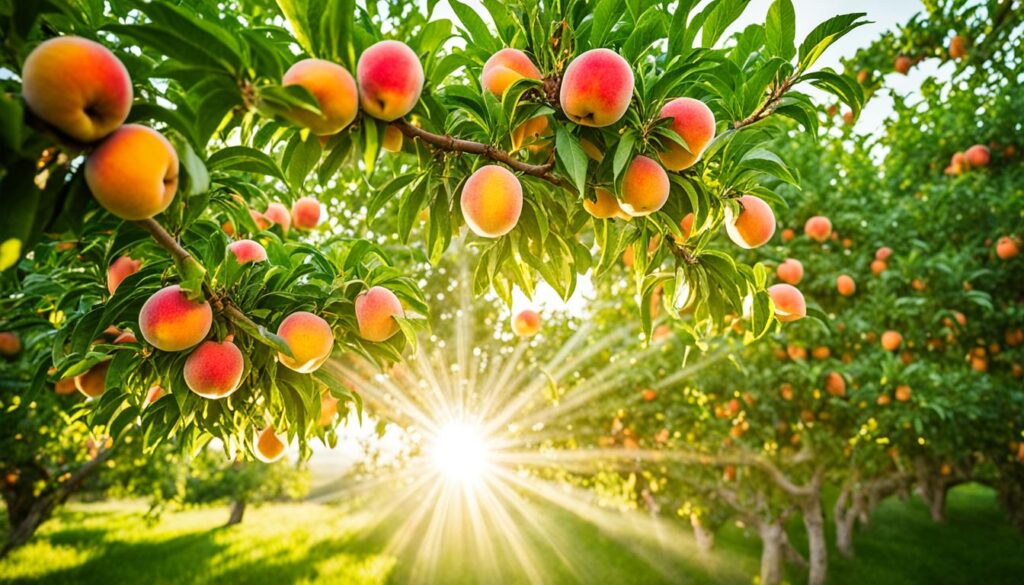
Choosing the Right Planting Spot for Peach Trees
Finding the perfect spot is key for your peach tree’s health and fruit production. They need lots of sunlight, protection from strong winds, and easy access for picking and care. Think about these things to make sure your peach tree does well and gives you lots of fruit.
Ample Sunlight and Wind Protection
Peach trees need at least 6 hours of direct sunlight each day to make lots of fruit. Pick a spot that gets a lot of sun and isn’t blocked by big buildings or trees. It’s also important to protect your tree from strong winds. Winds can hurt the branches and mess with pollination. Put the tree near a wall, fence, or something else that can block the wind.
Accessibility for Harvesting and Maintenance
Think about how easy it will be to get to your peach tree. Put it where you can easily walk to it for picking, pruning, and other upkeep. This makes taking care of your tree and picking the ripe peaches easier.
Choosing the right spot for your peach tree means you’ll get a lot of fresh, juicy peaches. With the right peach tree planting location, peach tree sunlight needs, peach tree wind protection, and peach tree accessibility, your tree will do great. You’ll enjoy a sweet taste of summer.
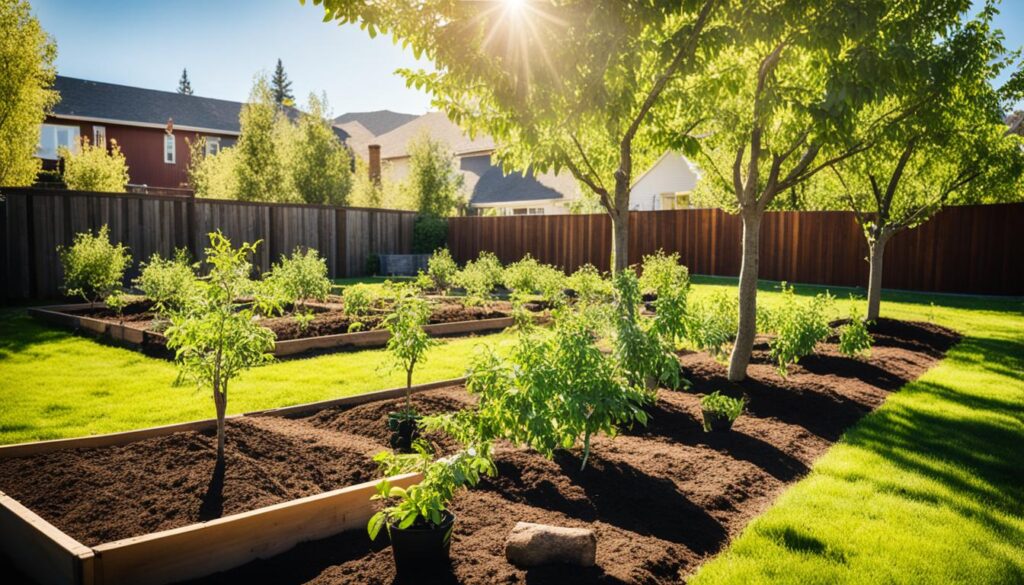
Preparing the Soil for Peach Tree Planting
Peach trees do well in deep, well-drained, and slightly acidic soil with lots of organic matter. To make a great spot for your peach tree, get the soil ready before you plant.
Improving Soil Drainage
Peach trees need good drainage to avoid waterlogging, which can cause root rot and other issues. If your soil is heavy clay or drains poorly, add compost or aged manure to make it better. Or, think about making raised beds for better drainage.
Adjusting Soil pH
Peach trees like soil that’s a bit acidic, between 6.0 and 6.5. Check your soil’s pH and fix it if needed. If it’s too alkaline, add elemental sulfur to lower it. If it’s too acidic, use pine bark or lime to make it more neutral.
Enriching with Organic Matter
Add a 2-4 inch layer of aged manure, leaf mold, or compost over the planting area. This gives your peach tree the nutrients it needs and helps with keeping moisture in and soil structure better.
| Soil Type | Characteristics | Peach Tree Suitability |
|---|---|---|
| Clay and Silt | Slick and sticky when wet, hold moisture well, resist water infiltration, easily compacted | Needs a lot of work to get it right for peach trees |
| Loam | Mix of sand, silt or clay, and organic matter, able to absorb and store moisture well | Perfect for peach trees, with good drainage and nutrient holding |
| Sandy | Light in color, coarse texture, allow moisture to penetrate easily, but do not retain water well | Works for peach trees if you add organic matter for better moisture and nutrients |
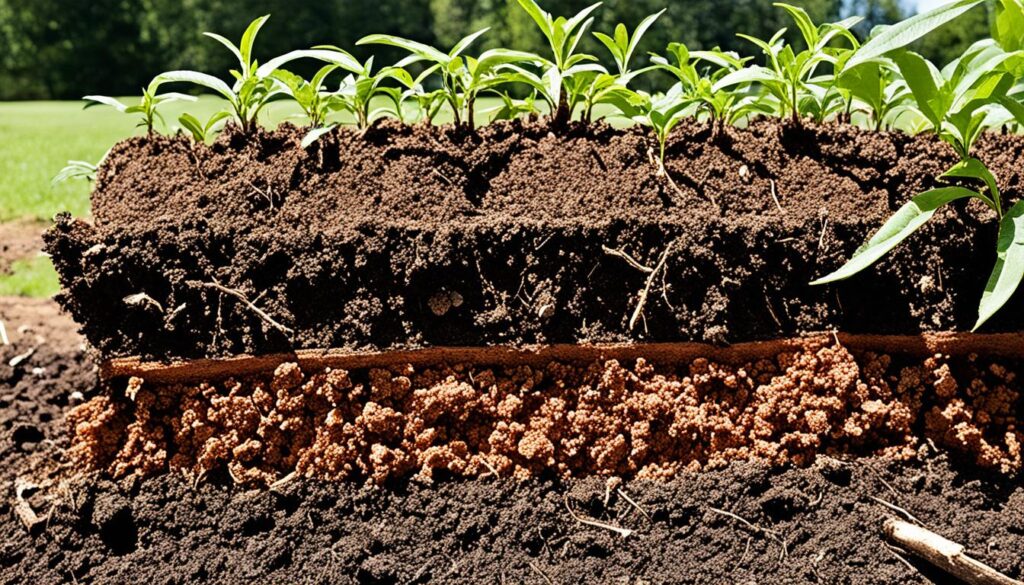
Planting Your Peach Tree
Spring is the best time to plant peach trees. This lets the roots get ready before the summer heat. Don’t plant in winter when it’s too cold, as the roots can get hurt easily.
To plant your peach tree, dig a hole that’s a bit wider and deeper than the root ball. Make sure the tree is planted at the same level it was in the nursery. Then, fill the hole back up without adding anything extra. Press the soil gently around the base.
- Space peach trees 8-10 feet apart for good air flow.
- Water well after planting, but don’t soak the soil too much.
- For dwarf and columnar peach trees, keep the graft union 2-3 inches above ground. For standard trees, it should be 1 to 2 inches below the surface.
Remember, soak the roots of bare-root peach trees for 1 to 2 hours. Don’t soak them for more than 6 hours. This makes sure the roots are ready before you plant them.
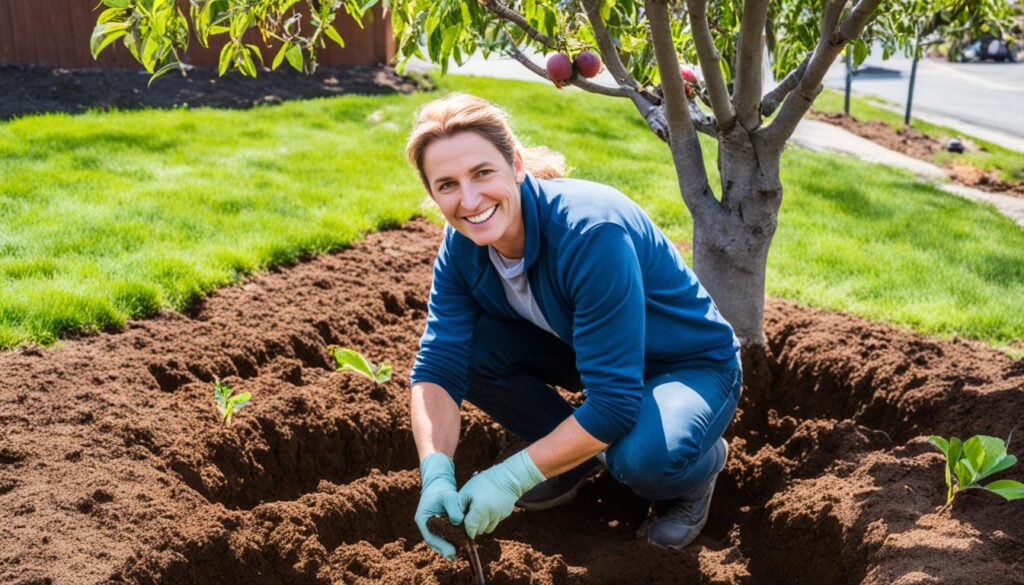
By following these peach tree planting tips, you’ll help your tree grow strong. This way, you’ll get a great harvest in the future.
Regular Watering and Moisture Management
Watering your peach tree often is key to its growth, especially when it’s young. Young trees need water more often, while older trees do better with a deep soak every 7-10 days in dry times. Keeping an eye on the peach tree’s root system and soil moisture is important for the right moisture levels.
Understanding the Peach Tree Root System
Peach trees have a wide, shallow root system that goes far beyond their canopy. This system helps the tree get moisture and nutrients. But, it means the soil around the tree must stay moist for growth and fruit.
Moderating Soil Temperature and Moisture with Mulch
Putting a 2-3 inch layer of organic peach tree mulch around the tree helps with soil temperature and keeps moisture in. This cuts down on how often you need to water. Just remember not to put the mulch too close to the trunk to avoid rot and other problems.
| Tree Size | Early Spring | Warm Spring/Fall | Hot Summer | Very Hot Summer |
|---|---|---|---|---|
| Dwarf – 2 years old | 0.62 gallons/day | 1.25 gallons/day | 1.56 gallons/day | 1.87 gallons/day |
| Dwarf – 4 years old | 6.20 gallons/day | 12.5 gallons/day | 15.6 gallons/day | 18.7 gallons/day |
| Standard mature tree | 18.6 gallons/day | 37.5 gallons/day | 46.8 gallons/day | 56.1 gallons/day |
By knowing your peach tree’s water needs and using peach tree mulch wisely, you can make sure it gets the right peach tree soil moisture. This leads to a good harvest.
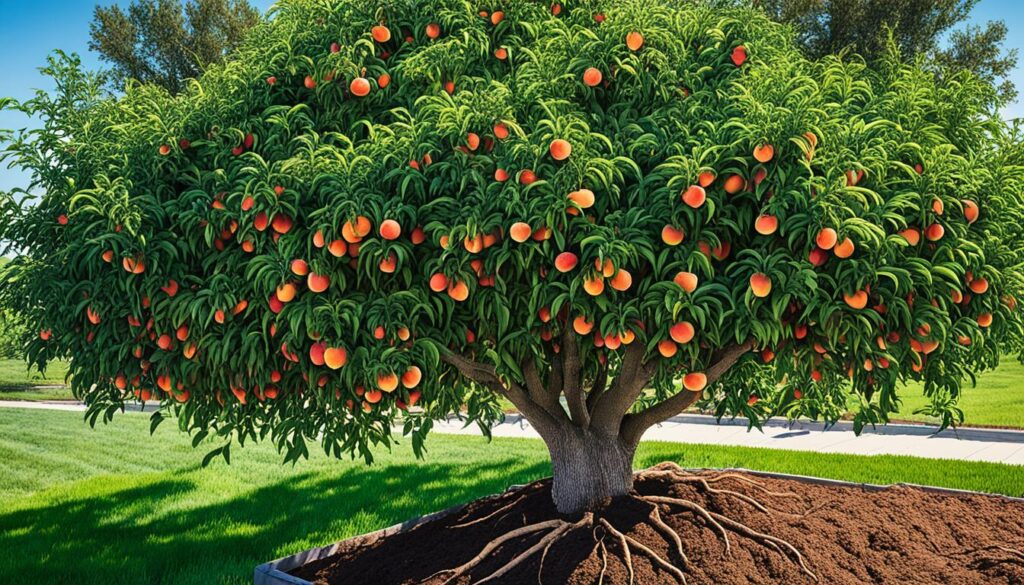
Fertilization for Healthy Growth
Proper fertilization is key for your peach trees to grow well and produce lots of fruit. A good planting spot is just the start. Adding peach tree fertilizer gives your trees the nutrients they need.
Start with a 10-10-10 organic peach tree fertilizer in early spring. This helps with growth and makes sure your trees have enough nitrogen, phosphorus, and potassium. Add the same fertilizer again after the harvest to keep the soil rich.
Adding organic compost is also good for your trees. It slowly adds nutrients to the soil. Watch for signs like yellow leaves or slow growth. Use organic fixes in the soil if you see these problems.
Young peach trees need more food than older ones. They are still building their roots and branches. As they get older, you can feed them less often but still give them the same amount of nutrients.
| Nutrient | Function | Deficiency Symptoms |
|---|---|---|
| Nitrogen (N) | Promotes vegetative growth, leaf development, and fruit production | Yellowed or reddish leaves, narrow or shrunken leaves, round dead spots on leaves |
| Phosphorus (P) | Supports root growth, flower and fruit development, and overall plant vigor | Stunted growth, poor flowering, and reduced fruit quality |
| Potassium (K) | Enhances disease resistance, drought tolerance, and fruit quality | Leaf scorch, early defoliation, and reduced winter hardiness |
Follow these peach tree fertilizer tips to keep your trees healthy and full of fruit. This way, your peach trees will grow strong, produce a lot, and stay healthy for a long time.
Pruning Peach Trees for Better Yield
Proper pruning is key for your peach trees’ health and productivity. Prune in late winter or early spring, before buds open. Use thinning cuts to open the tree, remove crossing branches, and control size and shape. This helps with air flow and light, which helps fruit set better and lowers disease risk.
Controlling Shape, Size, and Air Circulation
Keep the tree balanced, avoiding heavy side limbs that could break under the fruit’s weight. Pruning peach trees leads to stronger growth and larger trees after one season. Pruning is crucial for peach trees and nectarines, unlike other fruits.
Thin peach trees 20 to 40 days after full bloom, leaving 6 to 8 inches between each peach. Home gardeners can see better fruit size, color, and quality by thinning in May and June. This also helps with next year’s crop and prevents branch breakage, leading to a healthier yield.
A well-pruned peach tree with an «Open Center» shape gets more light and air. This is key for fruit development and fighting brown rot. For peach trees, wide branch angles help prevent splitting when carrying a big fruit load.
Pruning in July cuts down on shading, keeping the canopy’s interior for fruiting wood. Trees pruned in summer often need little pruning when dormant. Adjusting the crop load within 45 days after bloom by removing extra fruit helps. Hand-removing fruits can take a lot of time, but pruning and leaving fruit 4 inches apart makes fruit bigger.
Pest and Disease Control
Keeping your peach trees healthy is key for a good harvest. Problems like leaf curl, brown rot, bacterial spot, and borers can happen. By caring for your trees well, you can stop these issues before they start.
Prevention through Proper Care and Maintenance
Begin by spraying a dormant oil on your trees before the buds open. This helps keep pests and fungi away. You can also use organic neem oil to fight diseases and bugs like aphids and Lygus bugs.
Make sure your trees get enough sun, have good drainage, and are watered right. Prune them carefully to keep them strong against pests and diseases.
For pests like Peach twig borer and Fall Webworm, use products like GardenTech® Sevin® Concentrate Bug Killer. For fungal diseases, try Hi-Yield® Captan 50W Fungicide. Catching problems early helps protect your trees and gives you a great harvest.



